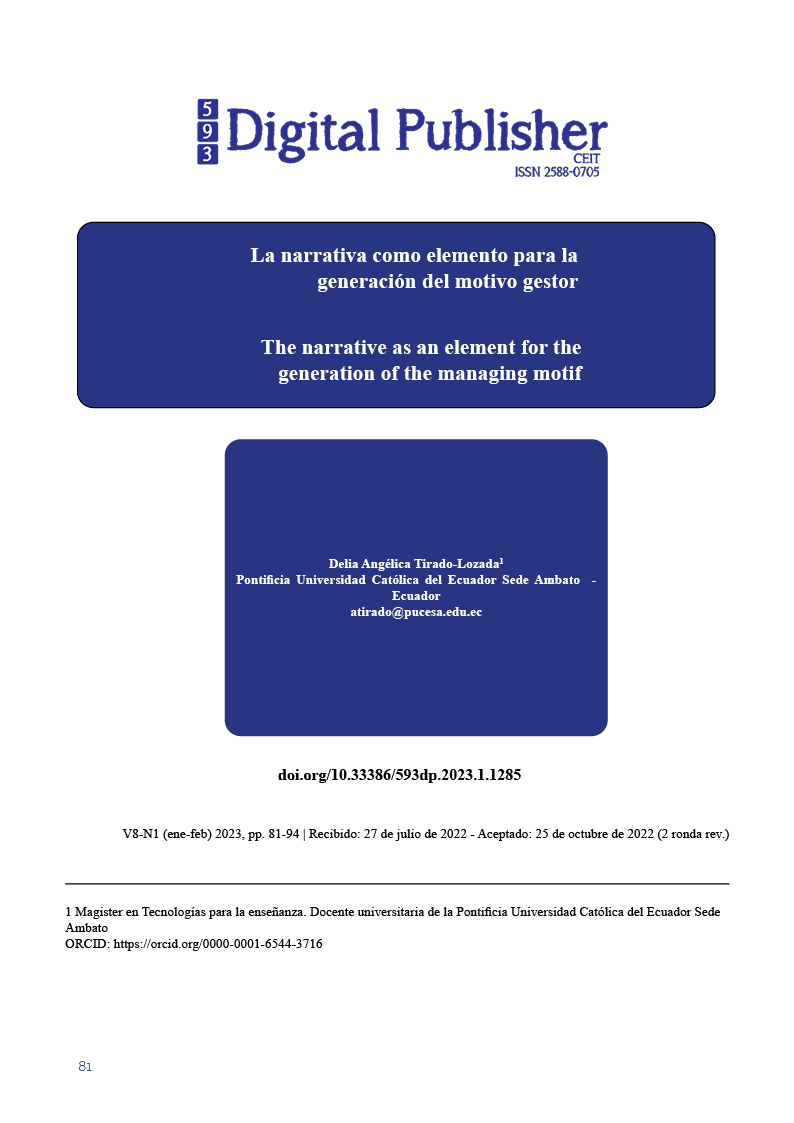The narrative as an element for the generation of the managing motif
Main Article Content
Abstract
The morphological processes developed in design educational institutions have limited the creative processes in students, since, by following traditionalist concepts dictated in the Three-Dimensional Basic Design subject, it has caused the morphological methods of design in students to stagnate; consequently, the design of objects does not present any innovation, and teachers look for methods that help develop versatile morphological processes that allow students to enhance their ability to generate new shapes in their products. The purpose of this research is to develop a morphological process that allows the generation of innovative products; narrative is used as an initial element for the conception of the managerial motive for interpreting new forms and concluding in the design of a product. The study makes it possible to demonstrate that the use of narrative can generate significant elements for the conception of objects.
Downloads
Article Details

This work is licensed under a Creative Commons Attribution-NonCommercial-ShareAlike 4.0 International License.
1. Derechos de autor
Las obras que se publican en 593 Digital Publisher CEIT están sujetas a los siguientes términos:
1.1. 593 Digital Publisher CEIT, conserva los derechos patrimoniales (copyright) de las obras publicadas, favorece y permite la reutilización de las mismas bajo la licencia Licencia Creative Commons 4.0 de Reconocimiento-NoComercial-CompartirIgual 4.0, por lo cual se pueden copiar, usar, difundir, transmitir y exponer públicamente, siempre que:
1.1.a. Se cite la autoría y fuente original de su publicación (revista, editorial, URL).
1.1.b. No se usen para fines comerciales u onerosos.
1.1.c. Se mencione la existencia y especificaciones de esta licencia de uso.
References
Aiche, O. (2005). El mundo como proyecto. Barcelona: Gustavi Gili.
Arroyo, F., & Bravo, D. (2020). El Proceso del Diseño Industrial como Herramienta de la Gestión de la Empresa. INGENIO, 3(1), 71-83.
Alexander, C. (1986). Ensayo sobre la síntesis de la forma. Buenos Aires: Infinito.
Barthes, R. (1977). Introducción al análisis estructural de los relatos . Buenos Aires: Centro Editor de América Latina.
Breyer, G. (2007). Heurística del diseño. Buenos Aires: Nobuko.
Chaves, N. (2006). El diseño invisible. Siete lecciones sobre la intervención culta en el hábitat urbano. Qué era, que es y que noe es el diseño. Intentando dispersar la bruma, en Actas de Diseño I. Buenos Aires: Universidad de Palermo: Madrid: Paidos Ibérica.
Gaito, J. (2018). La función social del diseño o el diseño al servicio social. Buenos Aires: Argentina : Universidad de Palermo .
Gutiérrez, J. (2020) Generación del concepto creativo publicitario en función del modelo de fases
sugerido por Graham Wallas: un estudio cualitativo basado en las teorías sugerido por Graham Wallas: un estudio cualitativo basado en las teorías asociacionista y gestáltica Rev. Braz. J. of Develop., Curitiba, v. 6, n. 1, p. 1252-1273
Hernan, T. (2009). Apuntes de morfología I. Argentina: Universidad Nacional de Córdova .
Heskett, J. (2005). El diseño en la vida cotiana. Barcelona : Gustavo Gili S.A. .
Iriarte-Pupo, A. J. (2020). Fenomenología-hermenéutica de la investigación formativa. El formador de formadores: de la imposición a la transformación. Rev. investig.desarro.innov., 10 (2), 311-322.
Idóneos. (18 de enero de 2022). Idóneos. Obtenido de Edmundo Husserl (1859-1938): https://filosofia.idoneos.com/344127/
Leinonen, T. (2010). Designing learning Tools - Metohodogical Insigts. Jyväskylä: Bookwell: Aalto University School of Art and Design.
Navarro, A. (2001). Introducción al concepto de diseño o cultura del proyecto en el mundo contemporáneo. En Lenguaje, comunicación y técnica. Santander: Jornadas de Formación el Profesorado. Consejería de Educación del Gobierno de Cantabria.
Leer la forma. (2009). Buenos Aires, Argentina: Redargenta Ediciones
Souriau P. (1904). La Beauté Rationale, París, Felix Alcan.
T, M. (1972). La speranza proyettuale. Mabente e societá (Turí: Einaudi) Traducción española de Hernán Mariano Cuevas. Buenos Aires: Nueva visión .
Urdinola, D. (2016). Estrategias para la emperimentoaión morfológica entre el diseño y la gastronomía. Manizales: Universidad de Caldas.
Valencia, A. (2009). Morfología experimental. esquema de formación en el diseño industrial . Tucumán.
Wong, W., Thevenet, H. A., & i Miralles, E. R. (1995). Fundamentos del diseño.


